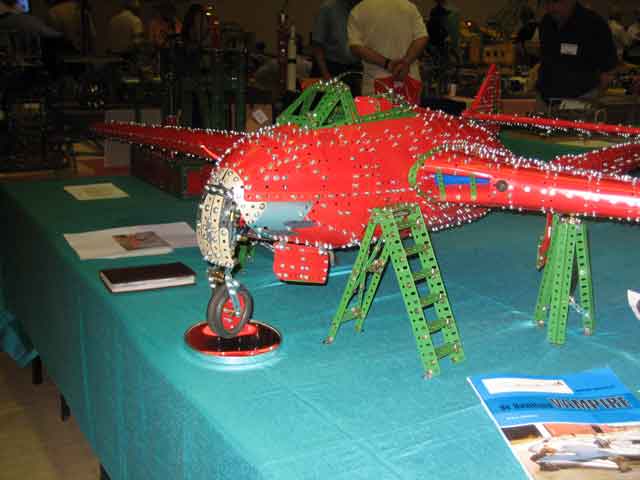
|
||
|
Ken Senar at work again with his meccano. This time it is a one sixth scale De Havilland Vampire FB5. The builder flew this type of aircraft over 50 years ago. The Vampire was the first single engine, single seater, jet aircraft to enter RAF service. The display simulates an aircraft on servicing jacks, such as would be used under maintenance conditions. This allows the undercarriage to be demonstrated. However, some licence has been used in as far as the guns can be 'fired' and the engine started, something that could never be done under such conditions. The model is 1/6th full size and replicates all the major features of the prototype. There are six 12 volt electric motors within; these operate the jet blast, flaps, air brakes, gunfire simulator, and the undercarriage legs and doors. Motor controls are mounted in a 1/6th full size model 'Trolley-Acc' (24 volt battery starter trolley) which is connected to the aircraft via a multicore cable in the manner of full-size practice. For model purposes only, a 12 volt supply cable feeds the Trolley-Acc from a transformer positioned below the display. There are over 4,000 bolts in the model. It weighs in excess of 70 pounds (32 kg) and breaks down into four major pieces for transport. The total display kit weighs about 110 pounds (50 kg). After a false start two years ago, following about 2 months of research work, the project was abandoned because of the difficulty of producing the required compound curves at 1/7th scale. (There are almost no true right-angle corners to be seen). Determined not to be beaten, the project was reassessed in January 2005 and a decision was made to attempt a build at 1/6th scale. This build commenced with the nose and nosewheel section and slowly and hesitatingly progressed until the present result was achieved over 12 months later. Probably something like four 'model equivalents' were built during this period. Construction was constrained so as to stay within the presently accepted range of Meccano parts. Exceptions are: micro-switches and wire, connector blocks, insulation tape, a fan for the jet blast, and perspex for the gun sight. Even the seat straps were packaging from a No.10 set! Save for less than a dozen bolts being shortened, and four nuts thinned, no Meccano has been modified other than by curving, and all parts can be returned to original condition. (Thanks to Eric Pigdon.) |
||